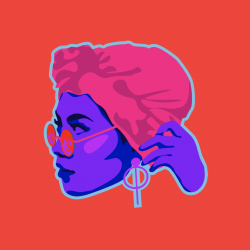What are Some of the current issues confronting our world today?
The concepts that I have chosen to explore are topics that I anticipate that I would have to educate my future children about. Issues that people find difficult to communicate:
 Concept 1: The widespread of Fake News.
Concept 1: The widespread of Fake News.
As fake news is getting more difficult to identify with the human eye, what are some ways to be vigilant in the era of “weaponised misinformation”? As technology evolves in the blink of an eye, humans have to keep up and develop internet survival skills.
- https://builttoadapt.io/the-design-of-trust-combating-fake-news-48548a9e209b
- https://medium.com/@caseorganic/fighting-fake-news-with-calm-design-principles-ae02d2874e8c
- https://www.sciencedirect.com/science/article/pii/S1877050917323086
- https://uu.diva-portal.org/smash/get/diva2:1181745/FULLTEXT01.pdf
 Concept 2: Keeping it Halal
Concept 2: Keeping it Halal
Halal is often associated with the food consumed, but what about the process of production? The concept of Thoyyiban (healthy and wholesome) is also forgotten, when Muslims depend too much on the logo, which can also be easily be copied and pasted. Now this begs the question: what makes things Halal?
- https://www.icv.org.au/about/about-islam-overview/what-is-halal-a-guide-for-non-muslims/
- https://www.sciencedirect.com/science/article/pii/S1877042814011446
- https://agroindustry.files.wordpress.com/2009/11/current-issues-in-halal-food.pdf
- https://www.researchgate.net/publication/285119498_Halal_food_issues_from_Islamic_and_modern_science_perspectives
 Concept 3: The reality of Emotional Abuse.
Concept 3: The reality of Emotional Abuse.
Emotional abuse can have longer lasting and deeper effects than victims of physical abuse. The term, being used loosely, making it difficult to properly categorise someone as the subject of emotional trauma. Victims also have a hard time discerning their situation, as it is difficult to spot the invisible signs.
- https://www.verywellmind.com/identify-and-cope-with-emotional-abuse-4156673
- https://www.cheatsheet.com/health-fitness/this-disturbing-sign-means-someone-is-a-victim-of-emotional-abuse.html/
 Concept 4: Is Pornography as harmless as it seems?
Concept 4: Is Pornography as harmless as it seems?
Porn has been normalised in society as a harmless personal entertainment. However, the material damages brains, relationships, and has negative effects on the society. There is also a dark open secret in the industry; the inseparability of pornographic material and sex trafficking.
- https://fightthenewdrug.org/3-reasons-why-watching-porn-is-harmful/
- https://fightthenewdrug.org/the-internet-can-be-a-very-unsexy-place-we/
- https://www.irishexaminer.com/lifestyle/features/how-to-educate-our-youth-about-pornography-addiction-and-dangers-439395.html
- https://fightthenewdrug.org/why-actor-terry-crews-wants-people-to-stop-watching-porn/
- https://www.google.com/search?q=The+truth+about+the+porn+industry+%7C+Life+and+style+%7C+The+Guardian&oq=The+truth+about+the+porn+industry+%7C+Life+and+style+%7C+The+Guardian&aqs=chrome..69i57j69i64.261j0j1&sourceid=chrome&ie=UTF-8
- https://www.glamour.com/story/15-sex-industry-workers-in-their-own-words
- https://www.psychologytoday.com/us/articles/200509/you-me-and-porn-make-three
- https://endsexualexploitation.org/educating/
To me, concept 4 is the one I feel for the most.
Why is the issue important?
Pornography is an important issue to me because it is a thriving industry that majorly benefits from exploiting a person’s darker side and people’s lives. While the internet has helped combine acts of kindness and compassion to alleviate human suffering on a global scale, it can also combine millions of selfish acts and create a massive force of harm.
Sex Trafficking:
As many people may know, the porn industry is a sketchy place. It gets even more difficult to tell if the content the “average joe” watches was made legally, or if all of the “actors” are there willingly (in some cases, they are coerced or threatened.) As technology makes getting this type of content easier, the viewers are getting younger. This drives the demand for more outrageous content, contributing to the cycle of sex trafficking, where majority of the victims are women and children.
Negative Effects to Society:
The representation of the lopsided power dynamics in pornographic films shows men as “powerful” and women as “submissive”. This raises concern as porn is the “perfect propaganda piece for the patriarchy”. Research has shown that “exposure to pornography has been shown to make viewers less compassionate towards victims of sexual violence & exploitation”. Other effects also include addiction which leads to broken relationships.
Other effects of porn:
https://fightthenewdrug.org/get-the-facts/#sthash.GFpmtMBa.dpbs
Who do you need to communicate to, and why?
The target audience includes mainly men, ranging from as young as 13 years old to 24, who have easy access to pornographic material on their portable smart devices such as phones, laptops, and tablets. They grow up on social media and are always connected to the internet.
The topic will also be set in Singapore, as it has been reported by Channel NewsAsia in 2018, there has been an increasing trend of younger people seeking for help for sex and porn addiction. Singapore is also a popular transit point and destination hub for trafficking activities, where traffickers exploit Singapore’s attractive economic conditions to lure victims:
There is a need to raise awareness on porn’s unethical secret and it’s negative impact on society to young, impressionable minds, who will grow up to be the future leaders of Singapore. When a large corporation is revealed to have unethical practices, consumers are quick to boycott and support other brands. It is time to advocate against the dark side society’s open secret, to stop the demand for outrageous content, and to promote healthier ways to cope.
Statistics:
- https://www.channelnewsasia.com/news/singapore/sex-porn-addiction-more-younger-people-seek-help-9963738
- https://fightthenewdrug.org/10-porn-stats-that-will-blow-your-mind/
- https://hagar.org.sg/human-trafficking-in-singapore/
How has visual communication contributed to address the cause?
Fight The New Drug, Apparel Merchandise, 2009 -2019.
https://store.fightthenewdrug.org/
Fight The New Drug, is a non-profit & non-religious organisation that advocates for people to make informed decisions about pornography and raising awareness on it’s harmful affects using facts and science.

For me, shirts are a method of campaigning that I feel is effective in showing your solidarity and support for the cause because it the graphics are big, and when people wear it, it attracts your attention because of the simple yet impactful designs and slogans on the merchandise. For example, one of their classic shirts, “Porn Kills Love”, to me sends out a very clear message of what the wearer stands for. In terms of the design, the serif font helps to make the shirt look serious instead of funny (i mean, not many people have the word porn on their shirts to begin with…).



Another one that I really like is the “Street Team Kit”, which is a kit designed for advocates to spread the message of the organization. I really like the design of the flyers, as the grunge yet digital aesthetic conveys a dangerous and serious context of online pornographic content. The colours are bright and bold, making it attractive to a younger audience, giving the poster a bit of an edgy vibe. I think that the other forms of campaigning included in the kit, like the shirt, patches, zines, posters and stickers give people multiple options to express their involvement with the cause, and because the design is attractive, it would help spark conversations.
Fight The New Drug, Website Design, 2009 – 2019.
‘https://fightthenewdrug.org/get-the-facts/#sthash.GFpmtMBa.dpbs
A lot of the information I got for my research was from Fight The New Drug’s website. If not for the very well designed website, I would have had a difficult time trying to get information.

To me, I like the website design because it makes good use of colour, motion graphics and typeface to make the organization look legitimate and current. The website is also welcoming as it makes use of the photograph of a group of young men and women (donning the organisations’ t-shirts), and the huge font that encourages us to “Join The Movement”. It speaks volumes about who their target audience is.


I also liked the organised categorisation of the website into three main topics: how porn affects the Brain, The Heart, and The World. The graphics are vectors that make the website look current and with the times, which is appropriate considering they are fighting against pornographic material on online platforms. To me, I find this very effective because I was able to find information quickly because of the organised website design, and the graphics drawn really complements the titles, giving me a visual cue of what the article is about.
Molly Gochman, Red Sand Project, Time based Installation, 2015.
‘https://www.youtube.com/watch?v=33grM0pFZjg, http://www.takepart.com/article/2015/11/29/red-sand-human-trafficking/

Molly Gochman is an activist highlighting Human Trafficking issues. Her work, the Red Sand Project, is peculiar in a way which does not directly address the issues of Human Trafficking on a visual level, but it unexpectedly gets people talking about the topic. It is a conceptual art that encourages viewer participation by getting people to buy packets of red sand and filling the cracks of the pavements and roads with it. The meaning behind the sand in the road cracks is a metaphor to highlight victims of Human Trafficking who “fall through the cracks”.
An interesting art project, very different from the other two I showed previously. It is more of a conceptual art, one that definitely caught my eye by how bold it is. It looks like streams of blood on the ground, which would stop anyone in their tracks and question what is going on. This is interesting to me because it turns the individual into a “participant” by simply making them question about it.

One thing I really like what the artist does is that when a person questions her what she is doing, bent down and spreading red sand, she responds by talking to them about her cause about highlighting about the hidden industry of Human Trafficking. In turn, the people become more puzzled because they were not expecting to have this conversation, but there they are, having that conversation. It’s quite funny actually, playing on shock value through visuals, making the spreading of awareness more interesting rather than preachy.
To me I think that this interactive installation art is very engaging as people all over the US have posted their participation to the Red Sand Project. The metaphor in the artwork is very powerful, in a kind of silent protest against the Human Trafficking industry.








